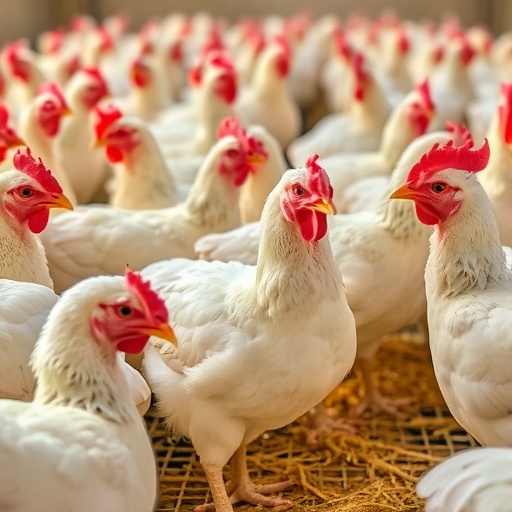Soybean meal has long been acknowledged as a primary protein source in poultry diets; however, it comes with its set of challenges. Anti-nutritional factors present in SBM, particularly mannans, can impede digestion and provoke immune responses, which may lead to energy wastage. Mannanase, an enzyme responsible for cleaving β-1,4-mannosidic bonds, emerges as a critical component in counteracting these issues. By digesting mannans, the enzyme not only helps to diminish intestinal viscosity but also enhances nutrient absorption efficiency, ultimately contributing to better overall health in broiler chickens.
Interestingly, despite the documented benefits of mannanase when administered individually, the interaction of this enzyme with a spectrum of SBM concentrations had not been conclusively defined prior to Guo’s investigation. This study thus aimed to fill this gap by meticulously assessing whether mannanase could effectively offset the negative impact of a reduced metabolizable energy level—concisely, a shortfall of 50 kcal/kg—particularly in diets with minimal or partial SBM inclusion.
.adsslot_NcQbeUgSTM{ width:728px !important; height:90px !important; }
@media (max-width:1199px) { .adsslot_NcQbeUgSTM{ width:468px !important; height:60px !important; } }
@media (max-width:767px) { .adsslot_NcQbeUgSTM{ width:320px !important; height:50px !important; } }
ADVERTISEMENT
The experimental framework involved a controlled 3×2 factorial design featuring Arbor Acres broilers. The researchers formulated three distinct diet plans based on varying rates of SBM inclusion (35.66%, 17.83%, and 8.92%), along with two different mannanase concentrations (either absent or present at 100 mg/kg). Each dietary treatment was executed under the aforementioned metabolizable energy deficit, allowing for an exhaustive evaluation of growth performance, nutrient digestibility, energy metabolism indicators, intestinal health parameters, gene expression levels, and changes in microbiota composition.
The results obtained from this multifaceted approach painted a promising picture of the mannanase’s efficacy. A substantial interaction effect was observed between the mannanase enzyme and different concentrations of SBM. The inclusion of mannanase significantly enhanced critical growth performance indices such as body weight and feed conversion ratio, primarily within the groups receiving higher SBM inputs of 35.66% and 17.83%. These advancements are crucial, considering the significant potential for cost savings and improved production metrics in the poultry sector.
Further investigation into respiratory metabolism revealed that chickens supplemented with mannanase exhibited a decline in oxygen consumption and carbon dioxide output. This metabolic shift was complemented by enhanced nitrogen retention and reduced nitrogen excretion, indicative of improved protein utilization. Notably, the highest SBM level of 35.66% yielded the most pronounced improvements in energy metabolism, as reflected in retained energy (RE) and net energy (NE) values.
Moreover, nutrient digestibility metrics showcased favorable outcomes owing to mannanase supplementation. Increased apparent total tract digestibility (ATTD) of crude protein and critical amino acids demonstrates the enzyme’s ability to optimize nutrient absorption. The intestinal health profile of the broilers also exhibited noteworthy enhancements; with a reduction in jejunal chyme viscosity, greater villus height, and positive changes in tight junction gene expression related to gut barrier integrity. Serum markers signaling barrier dysfunction were also noticeably improved, further corroborating the intestinal benefits derived from mannanase supplementation.
As anticipated, maananase’s anti-inflammatory properties played a pivotal role in altering the gene expression of inflammatory markers in the ileum. Specifically, the enzyme notably reduced the expression of pro-inflammatory cytokines such as IL-1β, IL-6, and NF-κB, while fostering a more favorable anti-inflammatory profile. This aspect not only emphasizes the enzyme’s potential in promoting gut health but also highlights its role in diminishing inflammatory responses that can adversely affect growth and performance metrics.
Additionally, microbial analysis conducted as part of the study indicated a pronounced impact of mannanase on gut microbiota composition. A marked reduction in populations of Escherichia coli and other pathogenic genera was observed, reinforcing the idea that optimizing feed composition through enzyme supplementation leads to a healthier gut environment. The research also indicated shifts in microbial metabolic functions, such as an increase in the pathways associated with 2-oxocarboxylic acid metabolism, which may further optimize nutrient utilization.
Despite the optimistic findings, it is imperative to note that the advantages seen with mannanase supplementation were diminished when SBM was reduced to a lower threshold of 8.92%. This revelation suggests an inherent limitation in the enzyme’s efficacy, strongly contingent upon the availability of its substrate. Consequently, poultry producers and feed formulators must bear this in mind when considering the application of mannanase in their feed strategies.
In conclusion, Yuming Guo and his team’s exploration of mannanase’s effects on broiler chickens underscores the critical intersection of nutrition, enzyme application, and gut health. As the poultry industry grapples with financing constraints and ingredient variability, this study offers a promising avenue—one that may not only improve feed conversion efficiency but also bolster environmental sustainability by reducing reliance on high-energy inputs traditionally needed for optimal broiler growth.
Subject of Research: Mannanase supplementation in broiler diets
Article Title: Impact of mannanase on broiler performance, intestinal health, and energy utilization with varying soybean meal levels
News Publication Date: 7-May-2025
Web References: https://www.maxapress.com/animadv
References: DOI: 10.48130/animadv-0025-0009
Image Credits: Maximum Academic Press
Keywords
Enzyme supplementation, poultry nutrition, broiler diets, soybean meal, mannanase, gut health, feed efficiency, microbial balance, energy metabolism, inflammatory response.
Tags: Anti-nutritional factors in soybean mealBroiler health and nutritionEffective feed utilization in poultryEnergy-restricted broiler feedingEnhancing broiler chicken growthFeed conversion ratio improvementGut inflammation reduction in chickensMannanase enzyme in poultry dietsNutrient absorption efficiency in broilersPoultry production feed strategiesSoybean meal nutritional challengesStable microbial environment in poultry





